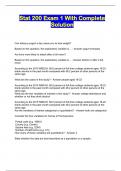Samenvatting
Psychological Assessment summary book+lectures
- Vak
- Instelling
- Boek
This document contains an in-depth summary of all the relevant chapters from the book "Psychological Diagnostics in Healthcare" by Luteijn and Barelds (2019). The book summary is integrated with all the additional material contained in the lectures, including the guest lecture.
[Meer zien]












